|
76. Coenonympha pamphilus (Linnaeus, 1758) / Small heath / Nymphalidae – Satyrinae
NL: hooibeestje / D: Kleiner Heufalter, Kleines Wiesenvögelchen, Gemeines Wiesenvögelchen / F: fadet commun, procris
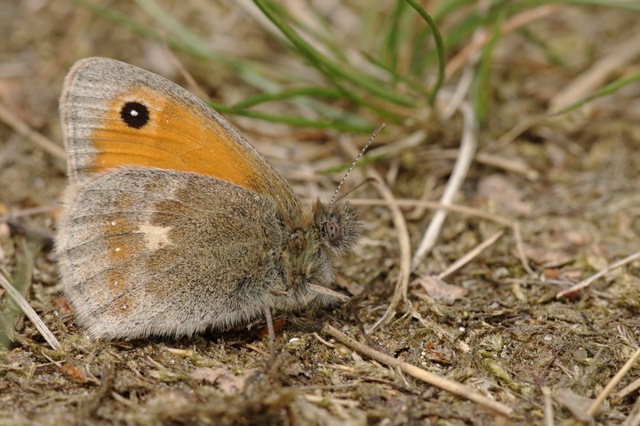 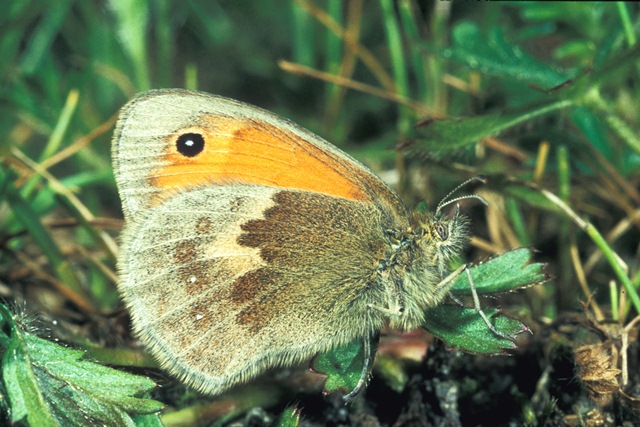 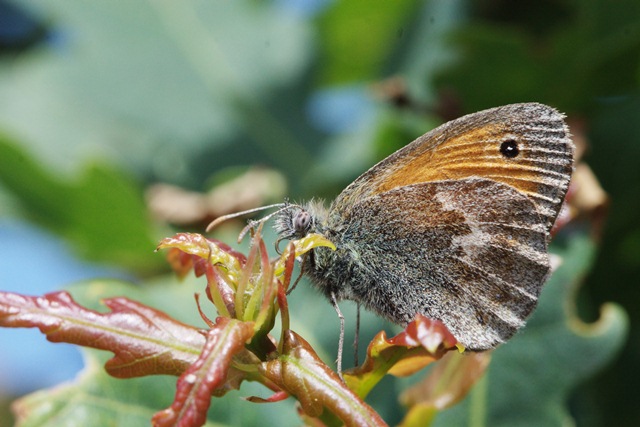
Photographs: Jeroen Voogd, Frits Bink, Jeroen Voogd ©.
Small, wing length 15 (14-17) mm. Occurs in the Benelux in nearly all types of landscapes: salt marshes, dunes, heathland and in the countryside on roadside verges, railway embankments, gently grazed pastures. It is ecologically a very versatile species.
Butterfly is on the wing from mid-May until mid-September and peaks early-June and mid-August. The species is known from maritime to continental climates, amplitude 4 to 17, required heat sum 400°d and maximum tolerated 2300°d, corresponding climate windows are 19 and 41 weeks.
In the United Kingdom the appearance of the butterfly from Scotland towards southern England gradually changes from one flight period in the north to two in the south (Asher et al. 2001: 280-283).
Experiments were conducted using this species on larval survival under various conditions of temperature, humidity, day length, host-plant species and soil fertility (see chapter 6 on development, capacity and limitation).
Ecological characteristics
Behaviour over time
Overwintering: in various larval stages, second, third or fourth instar in a tussock of its host-plant.
Reproduction: oviposition starts after 3-5 days when the body contains 55 (46-64) eggs, observed production twice as much.
Larval feeding periods: from early March until early November.
Generations: various, one up to three, depending on weather and population structure.
Spreading of risk: in larval growth rate, ending of diapause (up to eight weeks), adult lifespan and reproduction.
Life cycle: egg 13 (5-16) days; larva fast growing 35 (31-46) days, slow growing 9-49 weeks; pupa 14 (8-26) days.
Life span of adult: very variable, from 1 to 5 weeks.
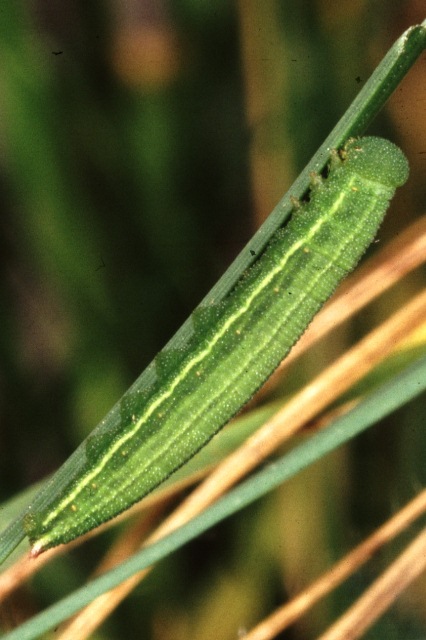 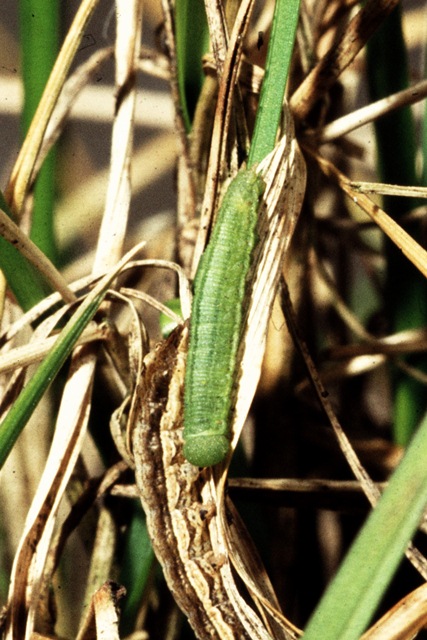
Photographs: Frits Bink ©.
Behaviour in space
From stay-at-home to migrant: stay-at-home, spatial requirement very modest.
Finding a mate: male patrols and surveys a territory.
Orientation in the landscape: on short grassland and patterns of short and medium tall grass.
Oviposition: selects the site but eggs laid randomly.
Defence
Threats from other organisms: avoided by cryptic appearance of larvae and adults.
Threats from the environment: endures drought and heat quite well.
Feeding habits
Adult: nectar of all kind of flowers in the herb vegetation.
Larva: feeding larvae can be observed very late in the season and very early in spring and may then display a basking behaviour.
Larval foodplants
Plant species accepted in experiments: Poaceae, Corynephorus canescens, Cynosurus cristatus, Danthonia decumbens, Festuca ovina, F. rubra, Lolium perenne, Koeleria pyramidata, Molinia caerulea.
Journal
Rearing experiments:
1. Based on specimen from Texel, Netherlands:
5 June 1980: female captured in dunes.
27 July: variable larval growth observed, from 5 to 12 mm in length.
4 August: one pupa.
12 August: adult appeared.
17 August: smaller larvae 8 mm in length ceased growing; others 21 mm in length, pupa near to hatching.
Overwintered outdoors.
24 January 1981: pot taken indoors.
18 February: larvae basked but grew very little.
13 May: adult appeared.
2. Based on specimens from Hoge Veluwe, Netherlands:
30 August 1985: two females captured in heathland.
31 August: 30 eggs laid.
12 September: eggs hatched.
16 October: larvae in L3.
11 December: in cold greenhouse, occasionally ate.
Larvae divided into 2 groups:
First group - overwintered indoors:
23 February1986: one larva appeared.
8 March: larva moulted L4-5.
28 March: larva nearly fully grown.
2 April: pupated.
Second group - overwintered outdoors;
4 April 1986: nine larvae in fourth instar, one in fifth.
16 April: some larvae prepared to pupate.
19 April: two pupated.
26 April: three larvae present in fourth instar.
2 May: adult appeared.
8 May: four pupae.
14 May: first of these pupae hatched.
18 May: all hatched.
Table 76-1. Results of dissections

Table 76-1a. Oviposition sequences

Table 76-2. Collection and observation localities
B, Nîsmes, Tiène Bieumont, 215 m, 50° 04’ 40”N – 4° 32’ 35”E; 28 May 1982.
B, Theux 50° 33’ 20”N – 5° 49’ 50”E; 17 June 1983.
B, Torgny, 237 m, 49° 30’ 40”- 5° 29’ 04”E; 19 June 1983.
B, Virton, 230 m, 49° 35’ 05”N – 5° 33’ 19”E; 19 July 1965, 19 June 1983.
D, Meetschow 53° 02’ 32”N – 11° 23’ 32”E; 22 June 1984.
D, Kaub 50° 05’ 36”N – 7° 45’ 43”E; 26 May 1986.
DK, Aalbeak 57° 37’ 10”N – 10° 17’ 25”E; 15 June 2004.
DK, Rømø 55° 07’ 54”N – 8° 30’ 21”E; 12 June 2004.
DK, Tofte Mose 56° 49 16”N – 10° 16’ 08”E; 4 July 2005.
DK, Ørnhej 56° 13´ 06”N – 8° 34´ 00”E; 14 July 2005.
F, Aurel, 400 m, 44° 43’N – 5° 16’E; 29 August 1984.
F, Ambleteuse 50° 48’ 09”N – 1° 36’ 57”E; 31 May 2001.
F, la Bruyère 45° 39’ 01”N – 5° 38’ 09”E; 25 August 1984.
F, Cap Blanc-Nez, 30 m, 50° 55’ 37”N – 1° 42’45”E; 1 September 1999, 10 June 2000.
F, Dommartin-la-Montagne 49° 01’ 51”N – 5° 36’ 53”E; 24 June 2006.
F, Lorraine, Dieue-sur Meuse 49° 05’ 11”N – 5° 27’ 25”E; 11 July 1984, 19 August 1984, 10 July 1985.
F, Lorraine, Jaulny, 209 m, 48° 57’ 55”N – 5° 52’ 52”E; 29 June 2002, 8 July 2006.
F, Maison-du-Bois 46° 57’ 57”N – 6° 25’ 17”E; 24 August 1984.
F, Normandy, Saint-Germain-sur-Ay-Plage 49° 13’ 13”N – 1° 37’ 36”W; 31 May 2000.
F, Normandy, Mare de Vauville 49° 37’ 55”N – 1° 50’ 56”W; 3 June 2000.
F, Vosges, Bollenberg, 363 m, 47° 56’ 54”N – 7° 15’21”E; 11 June 1984.
F, Vosges, Tourbière de Machais, 980 m, 48° 00’ 21”N – 6° 57’49”E; 24 July 1983.
F, Vosges, le Zinnkoepfle, 481 m, 47° 57’ 56”N – 7° 15’ 08”E; 3 September 1981, 10 July 84, 22 August 1984.
NL, Haaksbergen, Harrevelderschans 52° 08’ 59”N – 6° 46’ 45”E; 5 July 2003.
NL, Hoge Veluwe 52° 05’N – 5° 51’E; 11 July 1983, 30 July 1984, 5 July 1985, 30 August 1985.
NL, Hoge Veluwe 52° 04’ 47”N – 5° 49’ 47”E; 27 July 2000, 31 August 2000.
NL, Hoge Veluwe 52° 03’ 41”N – 5° 50’ 46”E; 31 May 2002.
NL, Kortgene 51° 34’N – 3° 48’E; 20 September 2003.
NL, Meeuwenkampje 52° 02’ 57”N – 5° 32’ 53”E; 9 June 1984.
Fig. 76-1. Coenonympha pamphilus, phenogram adapted from Bos et al. 2006: 223.
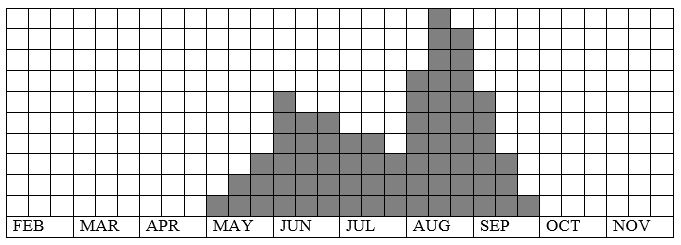
Fig. 76-2. Coenonympha pamphilus, habitat characteristics.
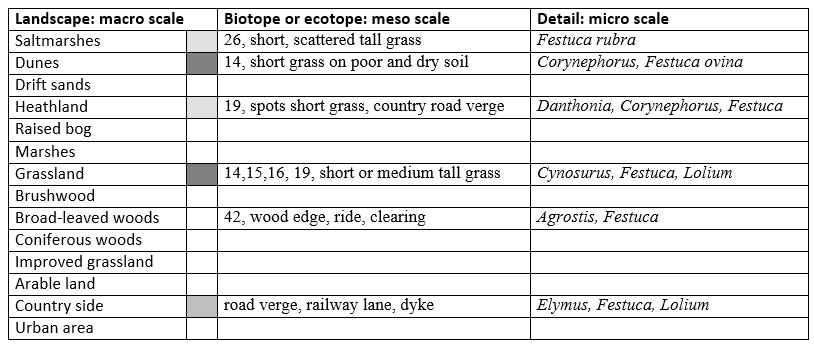
Fig. 76-3. Coenonympha pamphilus, climate matrix, heat-sums 400 - 2300°d.
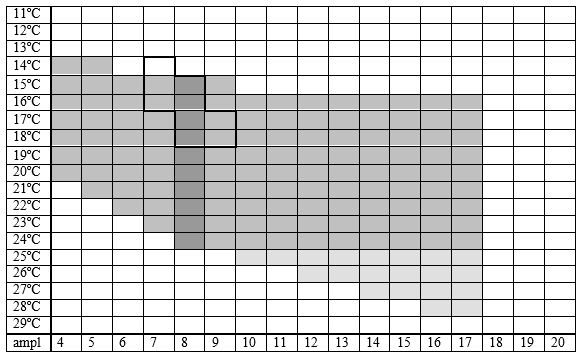
|











